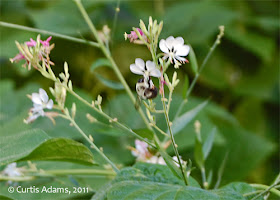 |
| Biennial Beeblossom in mid-September |
 |
| Basel rosette of Gaura biennis form in the first season |
 |
| Fresh flowers open at 9:30 PM |
 |
| A bumblebee making a landing on a Beeblossom flower. |
The flowers of G. biennis are pollinated primarily by long-tongued bees, especially bumblebees. When bees visit the flowers they grab on to the long stamen and crawl to the corolla to get the nectar. In the process their abdomen rubs against the anthers and stigma of the flower thus transferring pollen. Several moths also visit this plant. Two interesting pink colored species are the Primrose Moth, Schinia florida, found in the eastern US and the Clouded Crimson, Shinia gaurea, found in the western half of the US. The first 2 years I grew this plant I did not see too much insect activity, but this year there were a lot of bumblebees visiting the plant at sunrise, while the flowers are still relatively fresh (but alas, no pink moths that I have seen).
The original native range for Gaura biennis in the United States is from the Southeast to Midwest and Pennsylvania. Populations have been found further east and west the northern states including Massachusetts. The native habitat includes open and disturbed places, open woods and stream banks. It can tolerate a range of soil moisture from moist to dry and exposures from full to partial sun. Best growth occurs when there is good sun, and not too much water or fertilization provided (it can flop over when it grows too tall).
 |
| Even after cutting back in June, this plant is approaching 7 feet. |
This plant can be rather lanky. Its tall habit with long stalked flowers may make it a good candidate for creating a screen or a back-of-the-border plant. I can see combining this plant with the American Bellflower, Campanulastrum americanum, which blooms from the end of June to the beginning of August. As the bellflower dies out the Beeblossom would take over blooming for another 6 weeks or so.
Seeds are available from several sources, mostly based in the mid-west, including Prairie Moon Nursery and Ever Wilde Farms. For seed started indoors, a 60 day period of moist stratification is recommended. In my hands this gave reasonable, though not exceptional results. My first generation of plants have reseeded themselves with moderate vigor so that I have had several plants growing consistently since 2008.
 |
| Lindheimer's Beeblossom, Gaura lindheimeri. |

I had not heard gaura called "beeblossom" before, and I love that name. I have the more common linheimerii, so it was interesting to learn all about this biennial beeblossom.
ReplyDelete